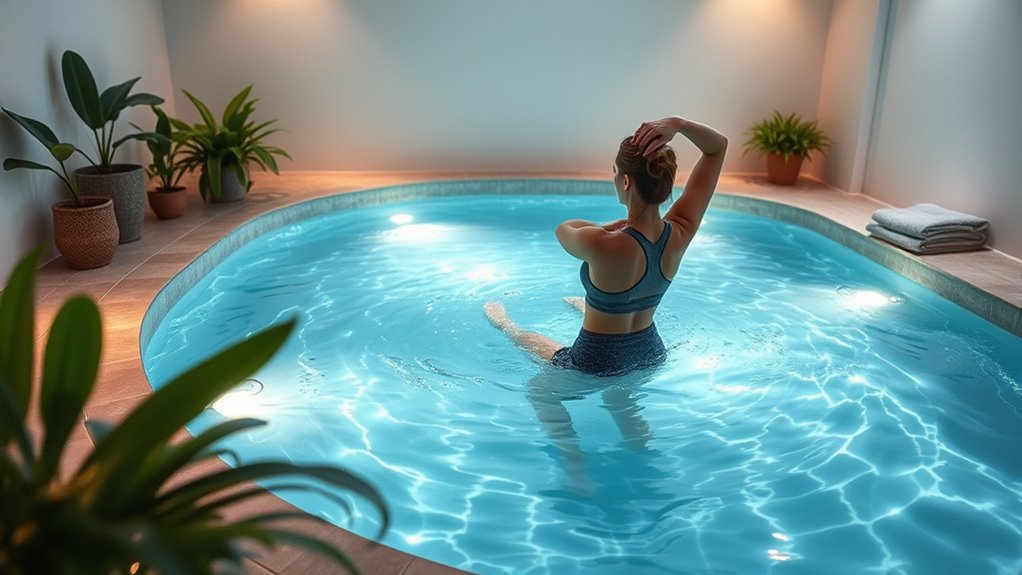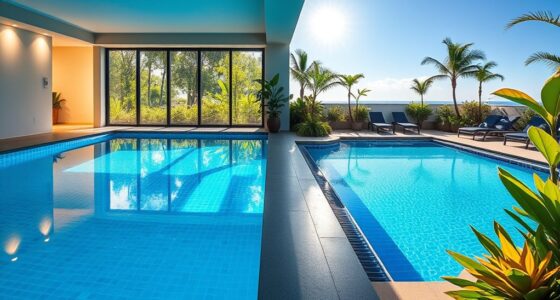To use your Endless Pool for pain relief at home, set it up in a safe, comfortable space with slip-resistant surfaces and adjustable lighting. Use warm water (92-98°F) for muscle relaxation or cold water briefly for inflammation. Incorporate gentle movements, targeted jets, and low-impact exercises like water walking to boost blood flow and ease pain. Adjust temperatures gradually and track your progress to stay motivated. Continue exploring these routines to maximize your comfort and recovery.
Key Takeaways
- Use warm water (92-98°F) with gentle movements and relaxation techniques to relieve muscle tension and promote pain relief.
- Incorporate targeted massage jets and adjustable water flow for focused relief on back and neck pain.
- Combine low-impact water jogging or resistance walking to improve circulation and support muscle recovery.
- Monitor water temperature carefully with a thermometer, adjusting gradually to ensure comfort and safety.
- Track progress regularly and modify routines based on pain levels and mobility to maximize long-term benefits.
Setting Up Your Endless Pool for Optimal Comfort
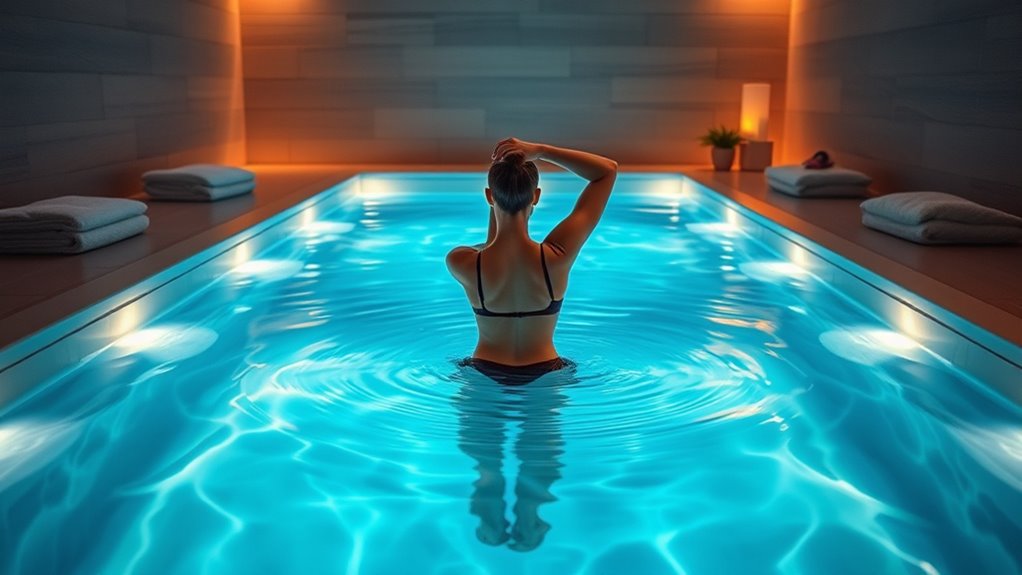
To guarantee you get the most out of your endless pool, setting it up for ideal comfort is essential. Start by positioning your pool in a quiet, shaded area to reduce glare and keep the water temperature stable. Ensure the surrounding deck is slip-resistant and level for safety. Adjust the water level so it’s just below the overflow edge, promoting proper circulation and easy entry. Invest in ergonomic accessories like comfortable seating or headrests to support relaxation during your routines. Proper lighting is also key—use soft, adjustable lights to create a calming environment. Finally, maintain good insulation around the pool to keep the water warm and save energy. Color temperature adjustments can also optimize the ambiance for your hydrotherapy sessions. These steps will maximize comfort and make your hydrotherapy sessions more enjoyable and effective.
Warm Water Therapy for Muscle Relaxation
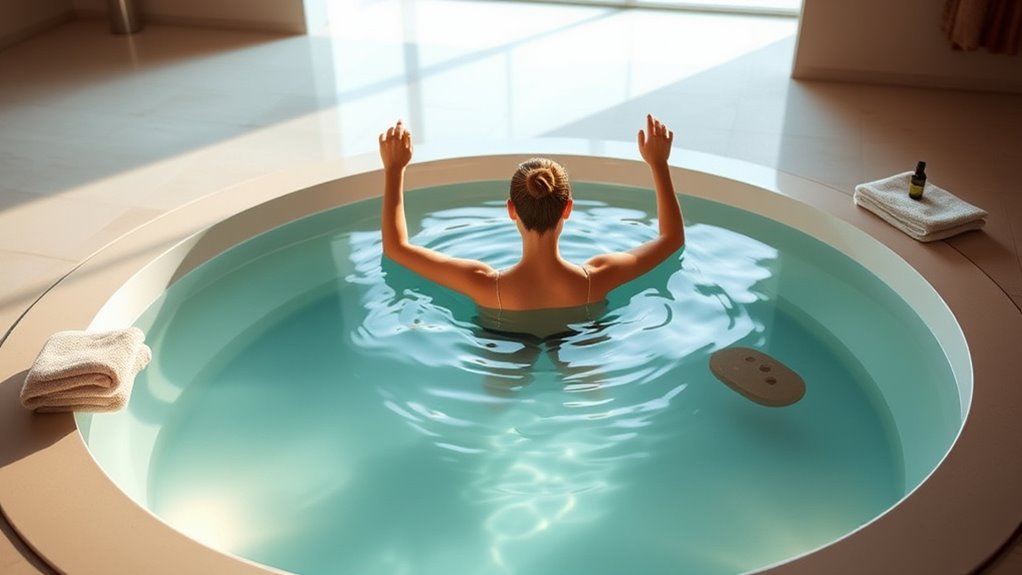
Warm water therapy is a highly effective way to relax muscles and relieve tension after your exercise sessions. The warm temperature increases blood flow, loosening tight muscles and reducing soreness. As you immerse yourself, you’ll notice your body unwinding naturally, making recovery smoother. To maximize benefits, focus on maintaining a comfortable water temperature, around 92-98°F (33-37°C). Use gentle movements or still immersion, depending on your needs. Remember, consistency is key to seeing long-term results. Warm water therapy doesn’t just ease muscle stiffness; it also promotes mental relaxation, helping you feel calmer and more centered. Incorporate this routine into your regular hydrotherapy practice for enhanced muscle recovery and stress relief. Mindfulness techniques can enhance your overall relaxation experience, helping you stay present and centered during your sessions.
Gentle Circulation for Improved Blood Flow
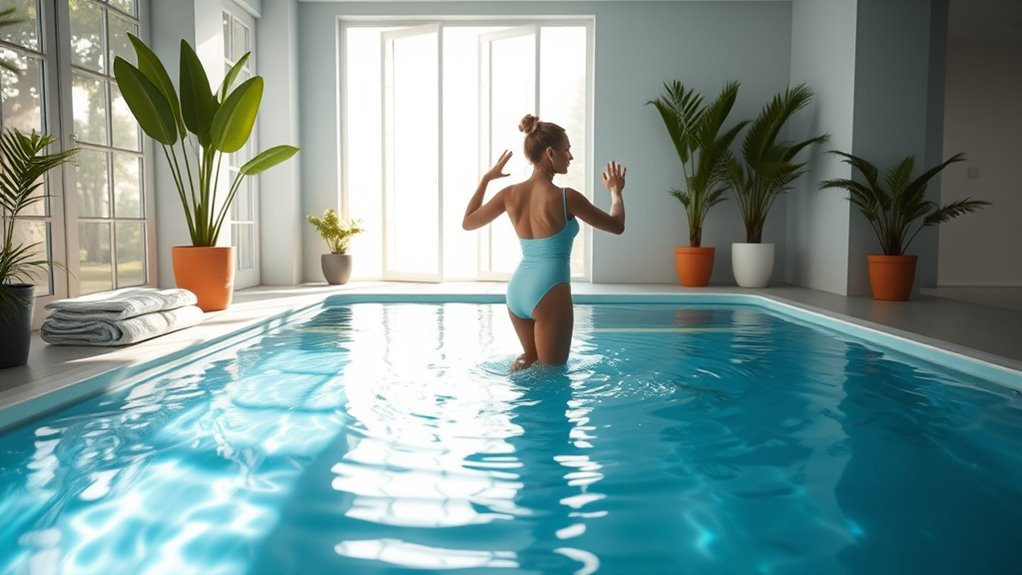
Gentle circulation techniques can considerably boost blood flow, accelerating your recovery and enhancing overall well-being. When you engage in slow, controlled movements in warm water, your body responds by opening blood vessels and increasing circulation. This process delivers oxygen and nutrients more efficiently to muscles and tissues, promoting healing and reducing stiffness. To maximize benefits, try simple routines like gentle arm circles or leg swings while standing in the pool. Focus on smooth, continuous motions that don’t cause strain. As your blood flow improves, you’ll notice increased energy and a reduction in soreness. Incorporating blood circulation practices regularly can support your body’s natural healing processes, improve mobility, and maintain overall health. Remember, consistency is key for sustained results.
Targeted Relief for Back and Neck Discomfort
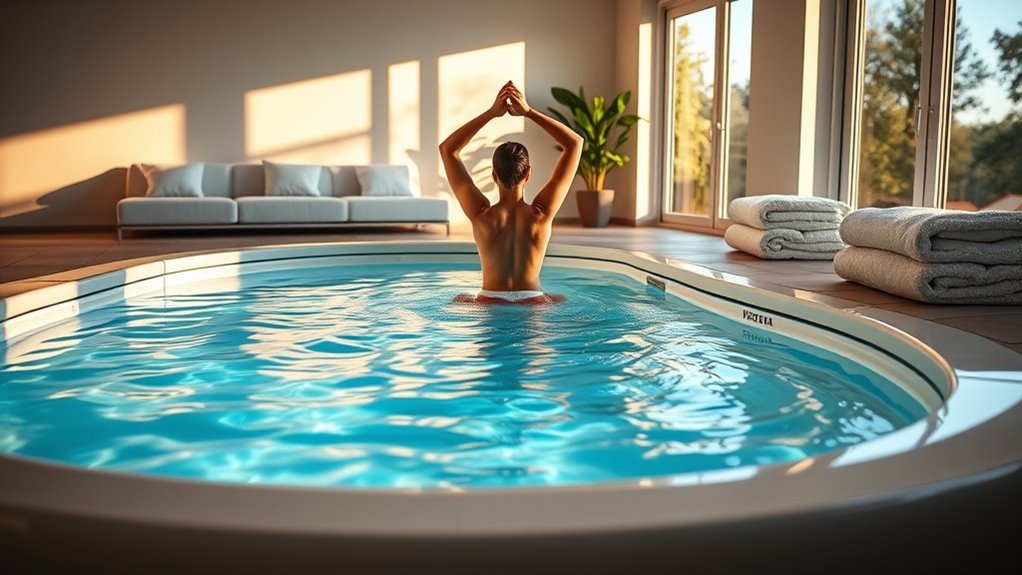
When you experience back or neck discomfort, targeted hydrotherapy can provide effective relief by directly soothing affected areas. Using adjustable jets and warm water, you can focus on specific spots to reduce tension and inflammation. This approach helps relax muscles, improve circulation, and diminish pain quickly. To maximize benefits, consider these tips:
- Adjust water temperature for comfort and muscle relaxation
- Use massage jets to target tight muscles precisely
- Incorporate gentle stretching beforehand to enhance relief
- Focus on areas with persistent pain for faster healing
- Limit sessions to avoid overstimulation or fatigue
Low-Impact Aerobic Exercises to Boost Mobility
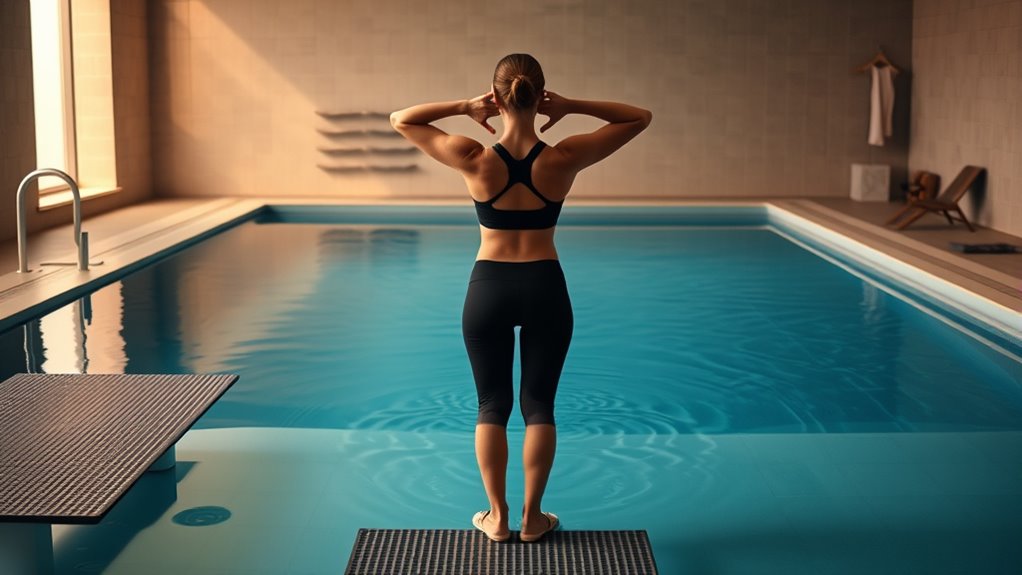
Low-impact aerobic exercises in the pool can help you improve mobility without straining your joints. Try gentle water jogging or resistance water walking to keep your muscles active. Using pool buoys during cardio can add variety and boost your workout’s effectiveness. Incorporating multi-functional equipment such as water weights or resistance bands can further enhance your exercise routine and promote better joint health.
Gentle Water Jogging
If you’re looking for an effective way to improve mobility without stressing your joints, water jogging provides an excellent solution. It mimics running without the impact, helping you build strength and endurance safely. To get started, stand upright in the pool, lift your knees slightly, and jog in place, maintaining a steady rhythm. Focus on controlled movements, breathing steadily, and engaging your core. This low-impact exercise enhances circulation, promotes joint flexibility, and reduces pain. Remember, consistency is key to seeing progress. Incorporating Kia Tuning options such as suspension upgrades can further improve your overall mobility and vehicle handling, just as water jogging enhances your physical mobility.
Resistance Water Walking
Resistance water walking offers an effective way to enhance mobility and build strength without putting undue stress on your joints. By adding resistance, you challenge your muscles more, helping to improve endurance and stability. To do this, walk in the pool with water resistance tools like ankle weights or resistance gloves, or simply walk against the current if your pool has one. Keep your movements controlled and steady, focusing on proper form. This low-impact exercise engages your core, legs, and hips, promoting better balance and coordination. It’s ideal for those recovering from injury or managing joint pain. Incorporate resistance water walking into your routine two to three times a week for gradual, sustainable improvements in mobility and muscle strength.
Cardio With Pool Buoys
Looking for an effective way to boost your mobility while protecting your joints? Cardio with pool buoys offers a gentle, low-impact aerobic workout that elevates your heart rate without stressing your joints. By using pool buoys to support your body, you can perform controlled movements that improve endurance and flexibility. This routine helps increase circulation, reduce stiffness, and promote overall mobility. Incorporate different exercises like leg kicks, arm swings, and torso twists to target various muscle groups. Remember, consistency is key for lasting benefits. Focus on controlled, steady movements to avoid strain and maximize your workout’s effectiveness. With time, you’ll notice increased energy, better joint function, and a sense of relief from pain or discomfort. Supporting joint-friendly movement can also help prevent future injuries and improve overall quality of life.
Using Water Jets for Deep Tissue Massage
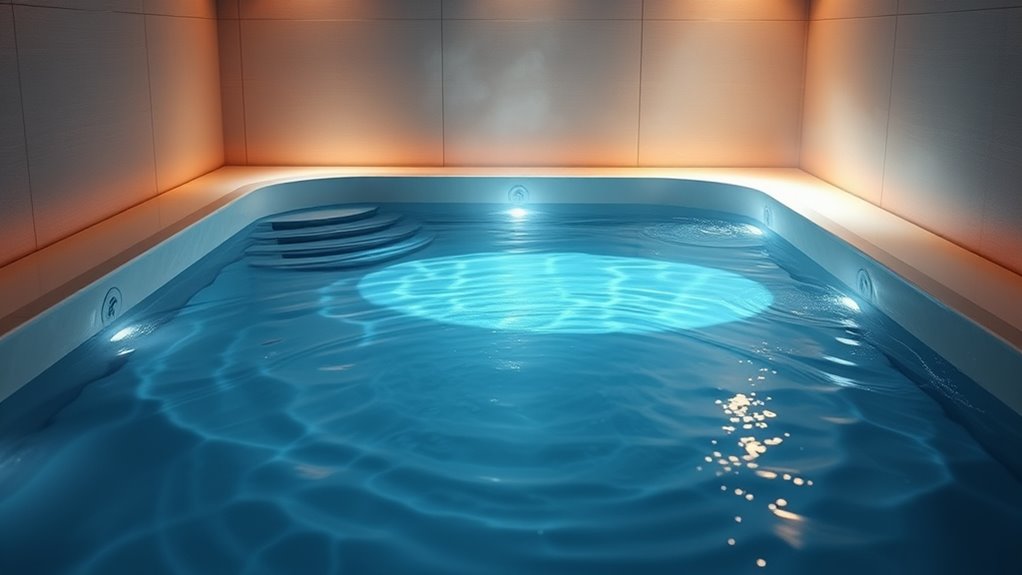
Using water jets for deep tissue massage offers a powerful way to target sore muscles and promote relaxation right at home. As you activate the jets, they deliver a focused stream of water that penetrates deep into muscle tissues, helping to release tension and reduce pain. You can adjust the intensity and direction of the jets to customize your massage, focusing on specific areas like your shoulders, back, or legs. This targeted approach helps improve circulation and eases muscle knots more effectively than passive soaking alone. Regular use of water jets can enhance flexibility and decrease stiffness, making it easier to move comfortably throughout your day. Incorporating water jet therapy into your routine provides a convenient, drug-free method to alleviate pain and support overall muscle health. Understanding industry trends can help you optimize your use of hydrotherapy devices and maximize their benefits.
Customized Water Temperature Routines for Chronic Pain
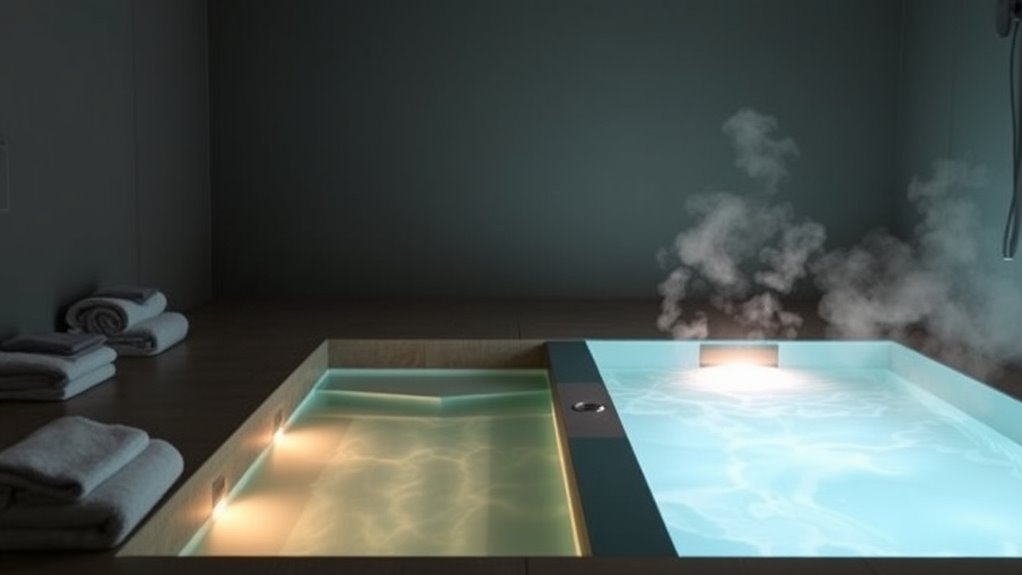
Adjusting water temperature can make a big difference in managing your chronic pain. You need to find ideal settings and tailor them to your specific ailments for relief. Always prioritize safety and comfort to guarantee your hydrotherapy routine is effective and enjoyable. Incorporating temperature control features can enhance your experience and ensure consistent therapeutic benefits.
Optimal Temperature Settings
Finding the right water temperature is essential for maximizing the benefits of hydrotherapy, especially when managing chronic pain. The ideal temperature varies based on your condition and comfort, but generally, keeping the water between 92°F and 104°F provides relief without overexerting your body. Too hot can cause dizziness or increase inflammation, while too cold might reduce circulation and slow healing. Adjust the temperature gradually, paying attention to how your body responds. Remember, consistency matters in establishing routines that work best for you. Proper installation and venting are also important to ensure safe operation and prevent gas buildup.
- Respect your body’s signals and avoid extremes
- Use a thermometer to ensure accurate temperature control
- Start with lower temperatures and increase gradually
- Keep sessions within safe time limits
- Regularly reassess your comfort to optimize relief
Tailoring for Specific Ailments
Since different types of chronic pain respond best to specific temperature ranges, customizing your water temperature routines can enhance relief and healing. For muscle tension or stiffness, warmer water—around 92-98°F—helps relax tight muscles and increase blood flow. If you suffer from joint pain, slightly cooler water, between 85-89°F, can reduce inflammation and discomfort without causing overheating. For nerve pain or conditions like neuropathy, a moderate temperature around 89-92°F provides soothing relief without intensity. Adjust your routine based on your symptoms and how your body responds. Consistently tailoring water temperature ensures you target your specific ailment effectively, optimizing pain relief and promoting recovery. Proper temperature management is essential to avoid discomfort and ensure safety during hydrotherapy sessions. Always monitor your comfort level and make modifications as needed to stay within safe and effective temperature ranges.
Safety and Comfort Tips
To safely incorporate customized water temperatures into your hydrotherapy routine, it’s important to prioritize your comfort and monitor how your body responds. Start with moderate temperatures and adjust gradually, noting any discomfort or relief. Always listen to your body—if you feel dizzy, overheated, or chilled, modify the temperature or duration. Use a thermometer to ensure water isn’t too hot or cold. Keep hydration in mind and avoid prolonged exposure to extreme temps. Remember, consistency is key, but never at the expense of safety.
- Know your limits and avoid pushing beyond them.
- Test water temperature before entering to prevent burns or chills.
- Stay hydrated to support circulation and overall comfort.
- Adjust routines based on daily pain levels and responses.
- Consult a healthcare professional if unsure about safe temperature ranges.
Relaxation Techniques With Hydrotherapy
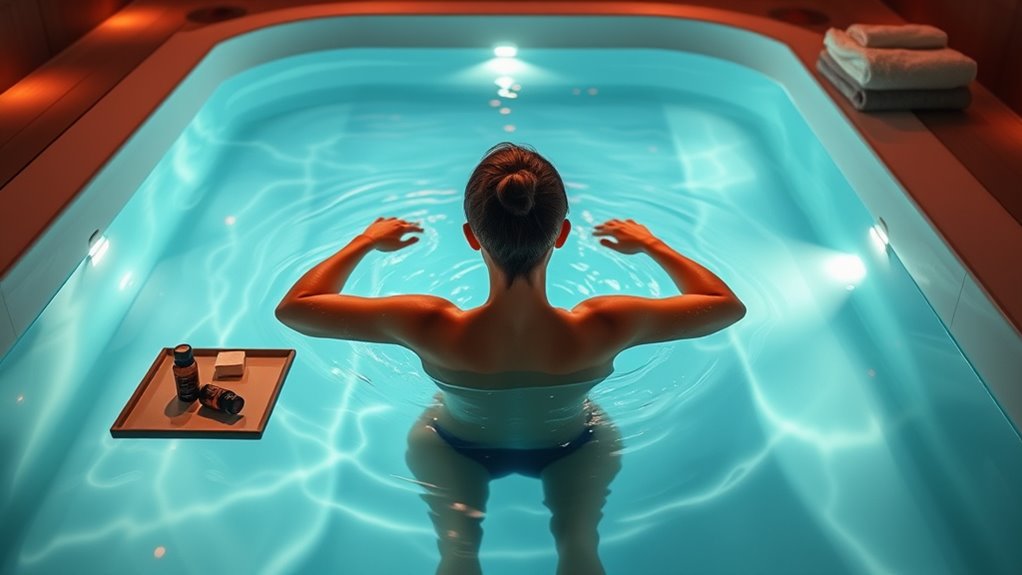
Relaxation techniques with hydrotherapy offer a simple yet effective way to unwind and reduce stress at home. As you immerse yourself in warm water, your muscles relax, easing tension built up from daily activities. Focus on slow, deep breathing to enhance this calming effect. You might try gentle stretching or floating to promote a sense of weightlessness and tranquility. Using aromatherapy or calming music while in your pool can deepen your relaxation experience. Consistently practicing these techniques helps lower cortisol levels, improve sleep quality, and boost overall well-being. Remember, the goal isn’t to push your limits but to create a peaceful environment where your body and mind can unwind naturally. Hydrotherapy becomes a personalized ritual for stress relief and mental clarity.
Managing Inflammation and Swelling at Home
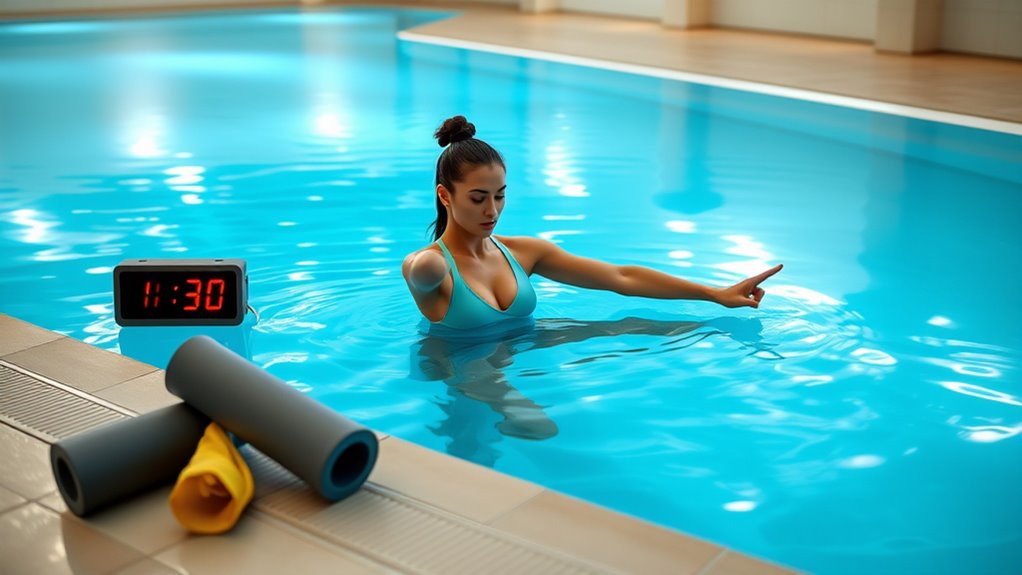
Incorporating hydrotherapy into your routine can also help manage inflammation and swelling effectively at home. The gentle flow of water reduces pressure on affected areas, easing discomfort and promoting faster recovery. Cold water therapy constricts blood vessels, decreasing blood flow to inflamed tissues, which limits swelling. Consistent use can prevent inflammation from worsening and speed up healing.
To maximize benefits, consider these tips:
- Use cold hydrotherapy immediately after injury or overuse
- Limit sessions to 15-20 minutes to prevent skin irritation
- Elevate swollen limbs during therapy for better results
- Combine with gentle movement to stimulate circulation
- Stay consistent for sustained relief and improved recovery
Incorporating Hydrotherapy Into Your Daily Wellness Routine
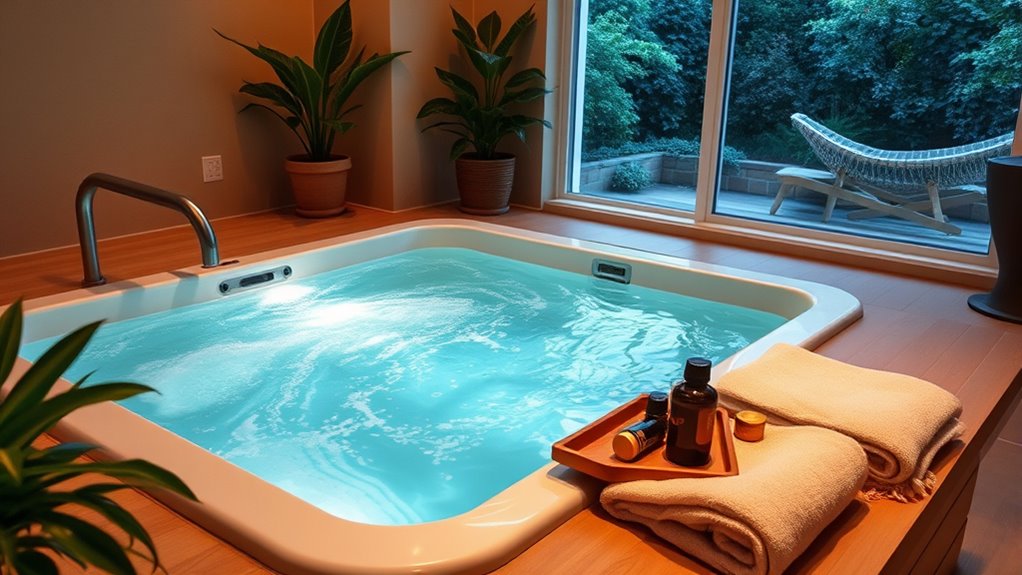
To make hydrotherapy part of your daily routine, start by establishing a consistent schedule that fits your lifestyle. Choose routines that target your specific wellness goals and stick with them consistently. Keep track of your progress to see what works best and adjust as needed for ongoing benefits.
Establish Consistent Schedule
Creating a consistent schedule for hydrotherapy guarantees you reap its full benefits and makes it easier to integrate into your daily routine. When you set specific times, your body adapts faster, and you develop a habit that boosts pain relief and relaxation. Stick to regular sessions, whether morning or evening, to build momentum. Consistency helps your body anticipate healing, maximizing the therapy’s effectiveness. It also minimizes skipped sessions, ensuring steady progress.
- Establish a specific time each day for hydrotherapy
- Keep a journal to track your sessions and progress
- Adjust your schedule as needed for better consistency
- Prioritize your routine to make it non-negotiable
- Recognize the importance of routine for long-term benefits
Choose Suitable Routines
Integrating hydrotherapy into your daily wellness routine becomes easier when you choose activities that fit seamlessly with your existing habits. Start by identifying what time of day feels most natural—morning, lunch break, or evening—and select routines that align with that schedule. Focus on simple, effective exercises like gentle water walking or relaxing dips that target your specific pain points. Consider your comfort level and mobility, opting for routines that challenge you without causing strain. Vary your activities to keep things engaging and prevent boredom. Remember, consistency is key, so choose routines you’re likely to stick with daily. By matching hydrotherapy exercises to your lifestyle, you make pain relief a natural, enjoyable part of your everyday wellness.
Monitor Wellness Progress
Tracking your progress as you incorporate hydrotherapy into your daily routine helps you stay motivated and adjust practices for better results. Regularly monitoring how you feel and noting improvements can reveal patterns and highlight what works best. Keep a journal of your sessions, noting pain levels, flexibility, and energy. Use simple tools like a wellness app or a checklist to track consistency. Recognize signs of progress to boost confidence and identify areas needing adjustment.
- Celebrate small victories to stay inspired
- Notice how your pain levels decrease over time
- Adjust routines based on your body’s responses
- Stay consistent for long-term benefits
- Reflect on overall improvements in mobility and mood
Frequently Asked Questions
Can Hydrotherapy Help With Chronic Conditions Like Arthritis?
Yes, hydrotherapy can help with chronic conditions like arthritis. You benefit from low-impact exercise, which eases joint pain and improves flexibility. Using an at-home Endless Pool, you can perform gentle routines tailored to your needs, promoting circulation and reducing stiffness. Consistent hydrotherapy sessions may also help decrease inflammation and enhance your overall mobility, making daily activities easier and reducing discomfort over time.
How Often Should I Use My Endless Pool for Pain Relief?
You should aim to use your endless pool about 3 to 5 times a week for pain relief. Start with 10 to 15-minute sessions and gradually increase as your body adjusts. Always listen to how you feel and avoid overexertion. Consistency is key, so setting a regular routine helps manage pain more effectively. If you experience discomfort, consult a healthcare professional for personalized guidance.
Are There Safety Precautions for Elderly Users?
You might wonder if using your endless pool is safe for elderly users, and the answer is yes—if you take proper precautions. Always consult a healthcare provider before starting, guarantee the water temperature stays comfortable, and stay within recommended session durations. Use non-slip mats, have a sturdy support nearby, and avoid water that’s too hot. These steps help prevent falls and overexertion, making hydrotherapy a safe, effective pain relief option.
What Accessories Enhance Hydrotherapy Benefits at Home?
To enhance hydrotherapy benefits at home, consider adding accessories like waterproof resistance bands to strengthen muscles, a non-slip mat for safety, and adjustable jets for customized massage. A waterproof thermometer helps monitor water temperature, ensuring ideal therapy conditions. You might also use floating noodles or cushions for support and comfort during sessions. These accessories make your hydrotherapy experience more effective, safe, and enjoyable, helping you achieve your pain relief goals more efficiently.
How Do I Prevent Infections When Sharing the Pool?
Imagine your pool as a sanctuary, shimmering with cleanliness. To prevent infections when sharing, you should shower thoroughly before entering, using soap to remove germs. Regularly clean the pool with disinfectants, especially after each use. Encourage everyone to wear swim caps and avoid swallowing water. Keep an eye on water chemistry, maintaining proper pH levels. These steps create a safe, inviting space for everyone’s hydrotherapy routine.
Conclusion
So, after all this talk about the magic of your home endless pool, it’s funny how something as simple as relaxing in warm water can turn your pain relief routine into a daily ritual. Who knew that the secret to easing discomfort might just be a few gentle laps and a cozy splash? It’s almost ironic—sometimes, the best medicine is just soaking in your own backyard, proving that the simplest solutions really are the most effective.
